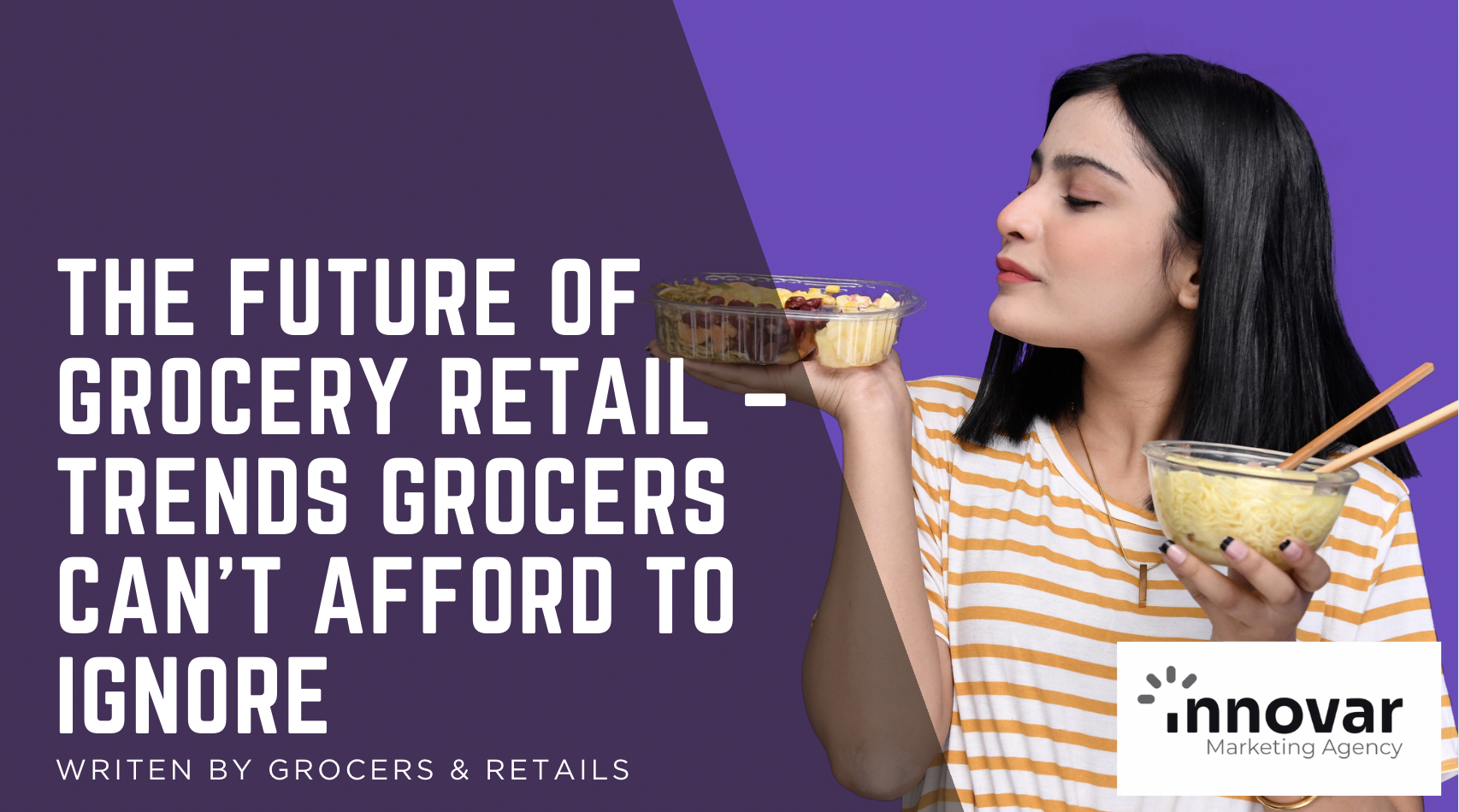The Future of Grocery Retail – Trends Grocers Can’t Afford to Ignore
The Future of Grocery Retail – Trends Grocers Can’t Afford to Ignore
Introduction
Grocery stores are no longer just about stocking shelves and checking out customers. In today’s fast-moving market, retailers need to anticipate consumer behavior, build brand experiences, and meet shoppers where they are—online, in-store, and everywhere in between. Thin margins and rising competition from mass retailers like Walmart and Amazon make this especially critical for regional and independent grocers.
With the grocery industry expected to hit $120 billion in eCommerce sales by 2028, grocers need to go beyond traditional promotions and pivot to customer experience, personalization, and storytelling. This blog dives into the seven grocery trends that are not only surviving in 2025 but thriving—along with strategies to help grocers stay relevant.
1. The Rise of eGrocery and Omnichannel Shopping
The eGrocery segment is growing nearly three times faster than traditional in-store grocery, with projections to reach 12.7% of all U.S. grocery sales by 2028. Pickup services alone are expected to grow 5.4%, outpacing even delivery.
Smart grocers are investing in better user experiences for mobile apps and websites. Whether it's seamless fulfillment for curbside pickup or flexible subscription models, grocers must match the convenience and personalization consumers expect from their digital lives.
Recommendation: Optimize your first-party platform to gather user data and refine product offerings and marketing. Tools like Mercatus and AisleOne allow for first-party engagement and help reduce costs compared to third-party marketplaces.
2. Social Media as a Sales Engine
TikTok, Instagram, and even LinkedIn are shaping brand perception and driving consumer purchasing decisions. Case in point: Saratoga Water's viral moment on TikTok not only boosted sales but impacted their stock price.
Monday Squares, a protein bar brand, built fierce loyalty through transparency and storytelling. Their founder shares real-time updates on the company’s wins and struggles, building trust and authenticity.
Goodwin's Organics, a Southern California retailer, saw their TikTok-famous smoothie line (Blue Lagoon for skin glow and Pink Paradise for immunity) explode among college students due to hyper-targeted content and influencers.
Recommendation: Partner with micro-influencers and creators who align with your brand’s values. Showcase staff, founders, or customers in content to humanize your store and build loyalty.
3. Private Label Product Expansion
Private labels now account for 20.7% of all grocery sales, topping $270 billion in 2024. What used to be a cost-saving alternative is now a curated, brand-worthy product line.
Walmart launched bettergoods, Amazon debuted Amazon Saver, and Grocery Outlet launched GO Brands—all focused on budget-conscious and health-conscious shoppers.
Recommendation: Develop store-brand SKUs with unique positioning (organic, local, value-packed). Use private label to differentiate from mass retailers and grow margins.
4. Personalized Loyalty and Subscription Models
Order frequency will drive 40% of eGrocery sales growth. The best way to capture recurring revenue? Personalized loyalty programs and tiered subscription models.
AisleOne and similar platforms show up to 14:1 ROI through automated promotions, loyalty offers, and personalized content.
Recommendation: Use AI to drive behavior-based segmentation. Think: smoothie punch cards, free coffee subscriptions, or early access to local produce.
5. Health and Wellness Product Positioning
"Eating well" is no longer just about nutrition. Consumers want products that align with their wellness journeys—low-sugar, gut-healthy a great example would be powder kombucha, added protein, or immunity boosting.
Goodwin’s smoothies were built around these values. Monday Squares aligns with clean ingredients. This trend creates massive opportunities for grocers to source or private-label functional foods.
Recommendation: Dedicate end caps and digital space to wellness-driven SKUs. Educate customers with short-form videos and in-store events.
6. Value-Driven Shopping and Smarter Promotions
Consumers are deploying nearly 4 cost-saving strategies per trip. Between inflation and rising food prices, promotions must be data-backed.
Instead of relying on blanket discounts, grocers should embrace dynamic pricing and personalized deals.
Recommendation: Use loyalty data to determine which households respond to which types of offers—targeted BOGO, digital-only flash sales, etc.
7. Investing in Technology and Retail Media Networks
Retail media is projected to hit $100 billion by 2028. While big names like Kroger and Albertsons are paving the way, regional players are using in-store screens, QR codes, and audio ads to engage shoppers.
Goodwin’s uses in-store TVs to display smoothie promos and health tips, building both brand and basket size.
Recommendation: Don’t wait for perfection. Start with basic digital screens, community partnership shout-outs, or sponsored recipe cards.
Conclusion
The future of grocery is hybrid, high-tech, and hyper-personal. Shoppers expect convenience, alignment with their values, and content that resonates. The stores that win will be those that embrace social commerce, data-driven loyalty, value innovation, and community storytelling.
Your shelves still matter. But so does your scroll.
Now is the time to invest in omnichannel platforms, product storytelling, and the influencers your shoppers already trust. Brands like Monday Squares and Saratoga Water show that loyalty can be built through transparency. Retailers like Goodwin’s Organics prove that even a small chain can become a viral sensation. Grocery trends for 2025 are not going any where and will contunie to grow so make sure your team is acting forward on new products, socail media and more!
Want to learn more let have a discovery call and see if we can help!

